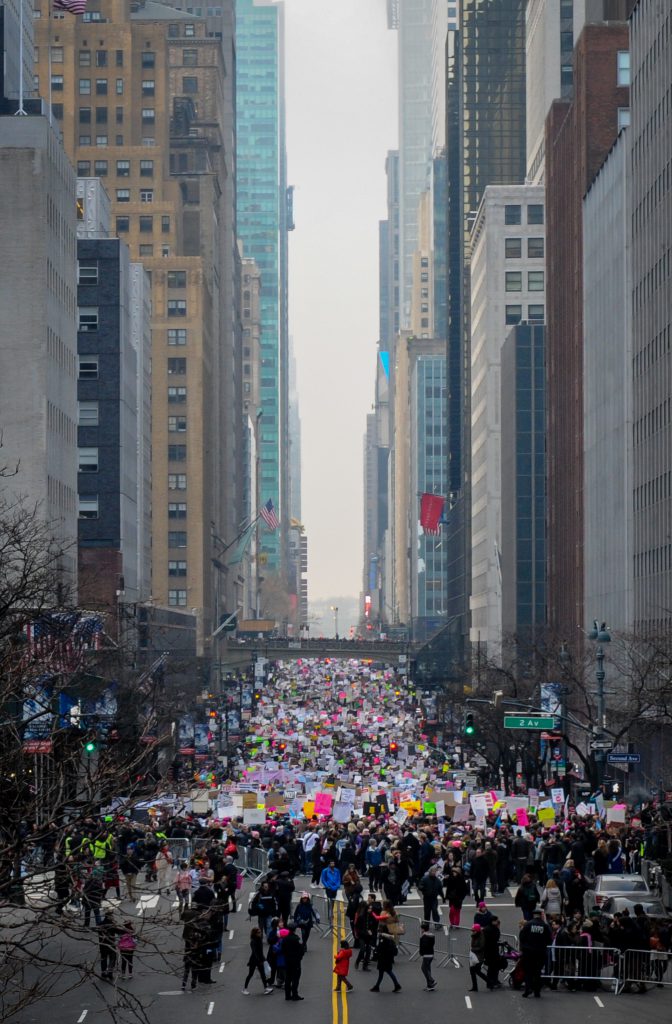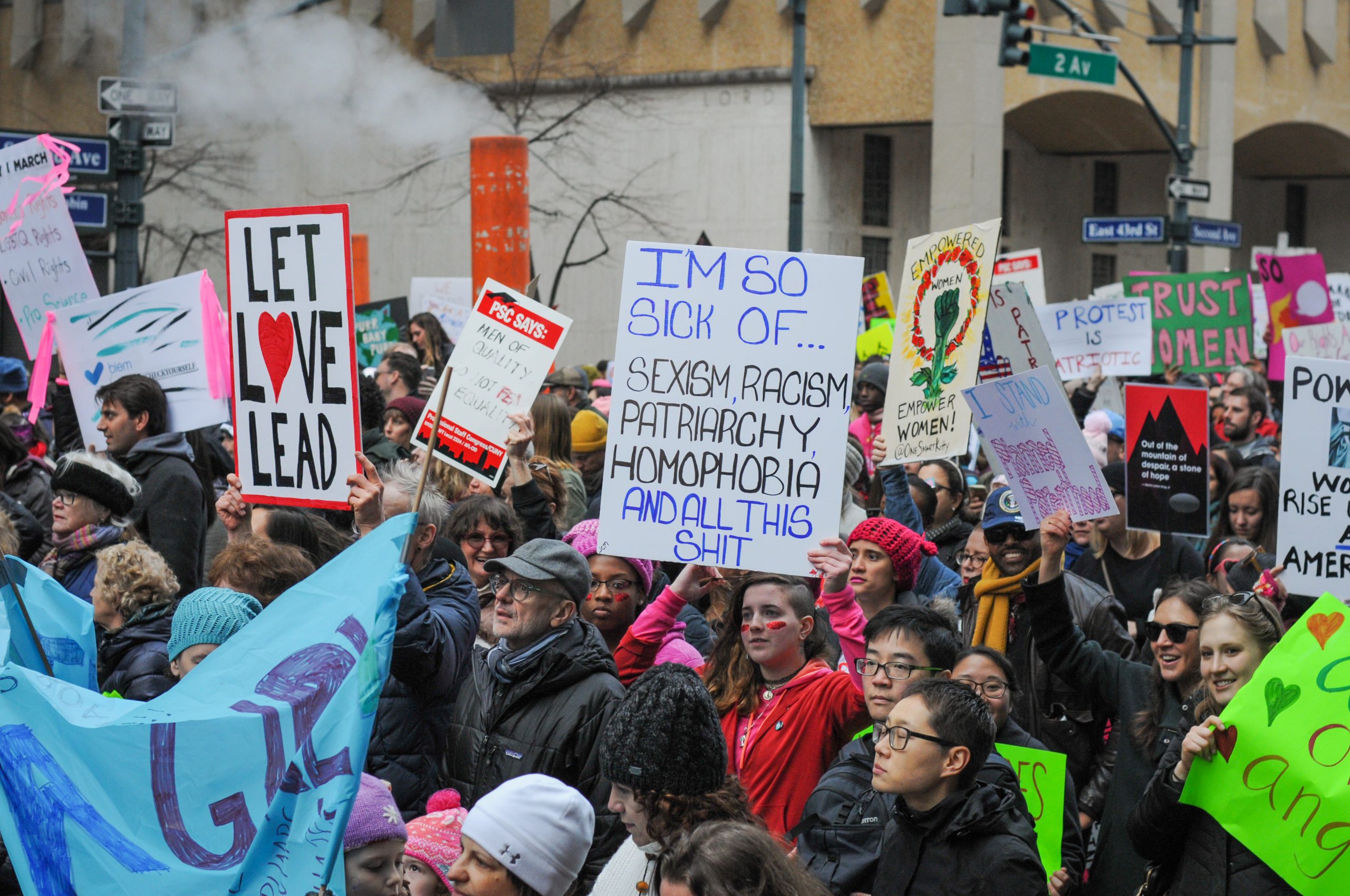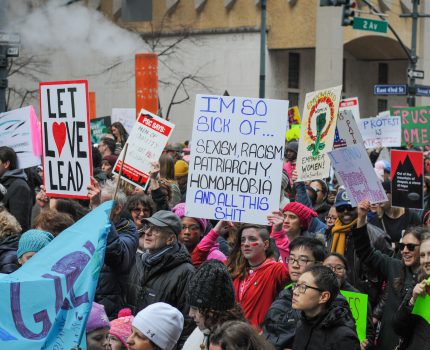When I was reading Twitter and Tear Gas by Zeynep Tukekci I really enjoyed how wove in conversations that she has had with activists all around the world. Inspired by this approach and keen to hear how some of the theories and issues we’ve been discussing in an academic context actually play out in real life, I interviewed Sophie Ellman-Golan about her experiences with activism and advocacy in the United States. Sophie is the Director of Strategic Communications at Jews for Racial & Economic Justice (JFREJ). Prior to joining the JFREJ staff, Sophie worked as a political and messaging strategist with a focus on antisemitism, and white nationalism, helping to expose ties between far-right movements and elected officials. Before that, she served as the Director of Communications and Digital Outreach at Women’s March. She holds a Bachelor’s Degree from Barnard College in Africana Studies and Human Rights.
Kasia: Could you give me a brief overview of your involvement in activism?
Sophie: I think my political engagement began in 2014 really when I graduated college. It was the same summer that Michael Brown and Eric Garner were murdered and that really politicized me. That’s when I joined an organization called Jews for Racial and Economic Justice (JFREJ) which is actually where I work now. So I was fresh out of college and working retail part-time so I had time at different hours and I was able to go to many of the protests happening in New York City and to live-tweet what was happening from the JFREJ account. And that was in some ways my accidental foray into the digital side of activism.
I remember feeling that it felt important to show that Jews were out there and part of this movement because there continues to be a struggle today that the loudest voices purporting to speak for Jews or the popular representation or understanding of who Jews are and what we care about, the issues that mobilize us, are not actually reflective of the vast complexity of who we are as a people.

Kasia: Could you provide some specific insights into the digital strategy for an organization/ movement you were involved with?
Sophie: There are a lot of different examples of this and I’ll give two that have very different objectives.
So firstly, in the very early days of the Women’s March, I was one of the people running our Twitter account and one of the things I was doing was what I would call ‘ally education’. It was taking advantage of the fact that we had sort of the rapt attention of women across the country and even the world, who were sort of listening to what we were saying but didn’t know a ton about issues like racial justice (here I’m speaking predominantly about white women) or ableism, sex work, etc. Twitter became a very useful tool to break down and unpack intersectional issues, but we also did a series of Facebook Lives. A lot of those were actually informed by really valid and important criticism that we got from activists online who we then collaborated with. Through this, we were also able to bring more awareness and light to all of these movements that had existed for a long time and direct attention towards them.
The other example is a project I worked on called Jews Against White Nationalism that ran through the 2020 election cycle. It was specifically designed to counter the way the Republican Party both used anti-Semitism and accusations of anti-Semitism simultaneously to divide progressive movements, consolidate power, and distract from the true machinations of why inequity existed. One of the big things that our project did was to track and research and then draw attention to the links between officials of the Republican Party and far-right extremist groups. We made a website called ‘How to Fight Anti-Semitism’ and it tracked instance after instance of anti-semitism from when Donald Trump began his campaign, through to January 6, 2021. The strategy was about creating an online repository that people could scroll through and see the sheer number of incidents that had happened. We also worked with partner organizations to share these more widely and there were some instances that became part of national news cycles as a result.
Kasia: Based on your experience, what do you see as some of the key affordances and challenges of our current platforms and wider digital ecosystem (policies, etc.), and how do they work in support of and against activism/social movements?
Sophie: Social media has made it possible for us to be able to transmit information quickly and in some ways, it has democratized who gets to be a critical voice on something. Yet at the same time, there is some danger with that, and that’s because when anybody can become a credible voice it becomes much harder to verify the information that we’re getting. I think many of us have this instinct to share things immediately, and while most of that is very well-intentioned, in the tracking we did of the far right I’ve just seen over and over how, in an effort to raise the alarm, people can actually fuel hysteria and make people afraid more afraid than they need be.
When anybody can become a credible voice it becomes much harder to verify the information that we’re getting…
Kasia: The vast majority of platforms being used by activists but also the general public are owned by massive corporations. Have you seen the negative impact of the commercial ownership of these platforms in your own work?
Sophie: This kind of relates to the saying that there’s ‘no ethical consumption under capitalism’ right? We’re fighting the monopoly of big tech and Facebook and yet at the same time, we’re using Instagram and Facebook to spread the word. There’s this sense of being forced to use the same tools that are actively colluding against us.
It is very hard to divest from this – a really good example is Amazon. Even if you don’t buy products on Amazon Prime they have a reach into so many industries and there are so many companies that also use Amazon Web Services to host their websites. They’re fundamentally integrated into the way we live our lives. So there is this cognitive dissonance that comes from being forced to use the same platforms that are hurting us, hurting our communities, treating their workers terribly while accumulating massive amounts of wealth – at the same time that we are in fights to break them up. I think we can’t pretend these issues aren’t there, but actually face this reality and engage with it and use it as an example of why it’s so critical to break up big tech.
So there is this cognitive dissonance that comes from being forced to use the same platforms that are hurting us, hurting our communities…
Kasia: And how do you think activists can deal with the highly crowded online environment?
Sophie: It’s very hard to constantly stand out and one of the ways to deal with this is to work in coordination and partnership with others. This is why I think coalitions are so important in organizing work because you can align and say “yes we’re all going to share something together” that’s a key component to breaking through the noise.
Kasia: The use of digital platforms allows activists/movements to mobilize many people quickly and potentially creates a lot of data. The temptation is to equate high numbers (of protestors, followers etc.) with “success”. However, academics who study movements have cautioned against making inferences about the capacity of activist organizations/movements from the numbers alone. What is your perspective on this? What implications do you think digital technology has for the assessment of the “success” of movements/activism?
Sophie: I learned this at the Women’s March, that you can have the biggest email list in the world but just sending out actions to people and hoping that they will organize them is not going to cut it. This is the distinction between just using digital tools and organizing. You have to cultivate a membership, you have to have people who are trained up, who feel that they’re supported in taking action, or who have their own local networks who will take action alongside them. Digital technology works to mobilize people very quickly and eliminates the barrier of getting the word out, but not without existing networks and not without foundations of organizing that have been laid beforehand.
…You can have the biggest email list in the world but just sending out actions to people and hoping that they will organize them is not going to cut it.
Kaisa: Do you think that digital technology has in any way transformed the relationship between social movements and/or activists and the formal development sector?
Sophie: I think that perhaps digital technology allows you to sort of gauge where there’s alignment between massive organizations and grassroots groups: Are they you know using similar language? Are they saying similar things? Are they in coordination with each other?
The other thing that comes to mind is that we’ve seen the emergence of these massive organizations and nonprofits that purport to represent a particular issue or group of people and to some degree digital technology allows people from those groups to say ‘you know we fundamentally disagree with you’. So it may make these organizations more accountable or at least inform the broader public that theirs is not the only perspective.
A huge thank you to Sophie for sharing her thoughts with me. Looking forward to your comments!

